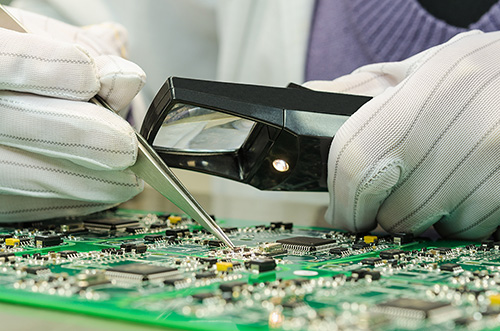Nothing is as costly to an manufacturer as a field-failure. Due to testing constraints, assembly professionals often have unresolved questions regarding the integrity of post-assembled parts and products. AIM’s Reliability Analysis Program provides analytical services such as solder joint and cleanliness analysis to ensure the integrity and reliability of these parts and assembled products before a failure occurs.
By cross-sectioning PCBs and analyzing their solder joints, AIM has the capability to provide the assurance that these solder joints are acceptable and offer advice on how to improve the quality of less-than-acceptable solder joints.
AIM’s complete organic laboratory has the ability to test PCBs for potentially harmful substances and interactions. Customers with concerns about the reactions of the various materials of a PCB with residues, salts, oils, etc. are invited to submit materials to AIM to be tested for compatibility, safety, and durability. Once reviewed, our technical department will offer recommendations in order to minimize the possibility that a product will experience a failure during its lifecycle.
 For more information contact AIM’s Technical Support department:
For more information contact AIM’s Technical Support department:
» 800 CALL AIM (225-5246)
Solder Analysis Service
The solder in a wave solder machine can become contaminated with other metals dissolved during the soldering process. These impurities can affect the physical characteristics and wetting ability of the solder, and may possibly result in defects such as icycling, bridging, pin-holes, webbing and non-wetting.
The AIM Solder Analysis Service is a program of scheduled analysis that can increase wave soldering throughput and reliability and reduce the rework of soldered assemblies. In order to maintain solder purity, a program of regularly scheduled pot analysis is recommended. The program allows customers to track solder pot impurities for conformance to IPC and/or internal requirements.
Analysis Report
AIM's Solder Pot Analysis Program provides a complete quantitative report on solder pot composition for preventive maintenance or for solving specific solder-related problems. AIM's analytical services are most often used to assure the solder pot has not become contaminated with other metals. Samples are analyzed to determine concentrations for tin and lead and a wide variety of contaminants through the use of analytical spectroscopy.
How to Order the Service in 3 Simple Steps
- Customer provides a purchase order for a certain number of solder analysis envelopes and is billed accordingly.
- The envelopes are sent to the customer via USPS unless the customer has an urgent need for them. In this case, the envelopes will be sent via FedEx or UPS at the customer's expense.
- Customer sends in a sample for analysis, using an authorized envelope. The sample should be 1" wide x 2" long or weigh 200 grams. Samples can be sent to the closest AIM facility or directly to AIM Montreal in urgent cases.
 To order now, or for additional details, please contact us.
To order now, or for additional details, please contact us.
List of Common Solder Pot Contaminants
Below is a list of common wave solder contaminants, their allowable limits and the steps to take to correct these:
| Contaminant* | Limit Precondition Surface % | LimitWave or Pot Soldering % | Possible Cause | Corrective Action** |
| Cu | .75 | .30 | Boards or leads have exposed copper | Cool solder pot to 370°F for 8 hrs and remove dross |
| Au | .50 | .20 | Gold pads or leads exposed to copper | Same as for copper |
| Cd | .01 | .005 | Cadmium coated shields or fixtures | Dump pot |
| Zn | .008 | .005 | Plated bolts or heat sink | Dump pot |
| Al | .008 | .008 | Heat sink fixtures | Dump pot |
| Sb | .50 | .50 | Not normally found except as an additive to solder | Dump pot |
| Fe | .02 | .02 | Occurs if pot is over heated; from pot, pump or other surfaces in the wave. | Dump pot |
| As | .03 | .03 | Not normally found except as a contaminant from recycled solder | Dump pot |
| Bi | .25 | .25 | Contact w/some surface finishes | Dump pot |
| Ag | .75 | .10 | Contact w/some lead finishes | Dump pot |
| Ni | .025 | .01 | Contact w/stainless steel | Dump pot |
| * | Limits set from IPC J-STD 001C DOD 2000A |
| ** | When precipitating copper from a pot make sure the pot is stagnant and is undisturbed for at least 8 hours. |
| Tin levels will typically drop over time. ±1.5% of the nominal tin content is acceptable. To raise this level, calculate the weight in your pot times the analyzed percentage. This gives the actual weight of tin. Take the weight of solder held by the pot and multiply it by .63; this is the amount of tin that should be in the pot. Subtract the analyzed weight from the theoretical weight. This is the amount of tin needed in the pot. Remove 15% more solder than this and add the calculated amount of tin. Top off the pot with bar solder. | |





